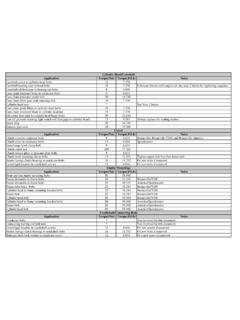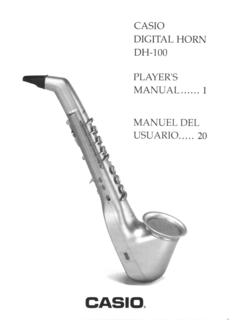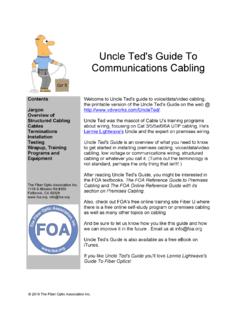Transcription of How to grow Dendrobium speciosum the Ted …
1 How to grow Dendrobium speciosum the Ted walmsley wayOver many years I have been asked how I grow my Dendrobium speciosums. So I put together this little guide to explain how I grow mine. HOUSINGWhen the plants are first deflasked they are put under 70% shade cloth where they remain until they reach the size of a 200mm (8 ) pot. They are then placed with the more mature plants under 50% shade cloth for the rest of their growing and flowering life. POTTINGWhen plants are first deflasked they are potted into 50mm (2 ) tubes using Mini Aus-Gro (Van Schaik s Quality Products) Orchid Bark (10mm). The plants are left in these pots until they fill the pot. They should not be allowed to overgrow the they fill the 50mm (2 ) tube, they are then repotted into a 100mm (4 ) pot using Medium Aus-Gro Orchid Bark (15mm). They are left in these pots until the pot is full, but again make sure they do not overgrow the pot. If the plant is allowed to outgrow the pot then when it is repotted it does not grow as vigorously as those plants not in an overgrown state.
2 I use standard pots (not squat pots), but crock 25-30% with styrofoam lumps. When the plant has filled the 100mm (4 ) pot it is then potted into a 200mm (8 ) pot using Large Aus-Gro Orchid Bark (20mm). After potting, 1/2 a handful of a 50/50 mix of Blood & Bone and Hoof & Horn is applied around the top of a 200mm pot (one handful for a 250mm pot or larger) and watered in lightly. The plants are then left to dry for 2 to 3 weeks before normal watering is recommenced. Repotting should then be done every two or at most every three years using the 20mm bark. Plants only show optimum growth when the bark is changed in this way plants do not progress in old, stale bark. At the 200mm pot size, most plants will flower. Under my conditions, providing regular repotting into new bark is done, I find that the period between deflasking and first flowering is generally about 6 years. FERTILISINGI believe the best procedure is to water one day and to fertilise the next day.
3 I never fertilise into a dry potting mix because, while the plants must never be waterlogged, I feel that if the mix and roots are damp and fresh they will be more able to make use of the fertiliser as the roots will be more active than if the mix is dry. However, it is always better to be on the dry side with your plants rather than having them too two (2) months during the growing season I apply a solution of Condy s crystals (potassium permanganate) and Epsom Salts (magnesium sulphate heptahydrate). This is made up by dissolving 10 grams of Condy s crystals and 100 grams of Epsom Salts in 20 litres of water. This solution is then applied through a 1/16 fertilizer/water mixer. The solution as applied to the plant therefore contains about 1 gram of Condy s crystals and 10 grams of Epsom Salts per 32 litres of water. Both Condy s crystals and Epsom Salts are available, for example, through Selby Biolab (national customer service no 13 2991, minimum amount 500g).
4 In addition to the above, every six months I like to top dress the plants with the 50/50 Blood & Bone and Hoof & Horn mix at the rate of one (1) teaspoon for a 100mm (4 ) pot and half a handful for a 200mm (8 ) also use a soluble fertiliser ( grow Force Flowfeed GF9) two to three times a year during the growing season at the manufacturer s recommended concentration (in the case of grow Force that is about 3g/L). I am a firm believer in liming your plants, and have the philosophy that TOO MUCH LIME IS NOT ENOUGH. I use hydrated lime or Brickies lime (calcium hydroxide). I lime my plants as often as they need it, even up to six (6) to eight (8) times a year depending on the weather. I put the lime on as thick as it is needed to give good coverage on the AND DISEASESP revention is the best cure for all ailments or pests which may affect your insects, I rotate the use of Rogor (dimethoate) [eg mfd by Richgrow Garden Products] and Lorsban (active is chlorpyrofos an equivalent active is in Richgrow Lawn, Beetle & Grub Killer) at two monthly intervals of spraying so I end up spraying for insects six (6) times a year.
5 Take care to read and act on all manufacturers safety directions before using these fungal problems I also spray every two (2) months alternating with the spraying for pests. For this I use Agri-Fos (mfd by Agrichem Manufacturing Industries based on a phosphorous acid containing active). Another product based on the same active is Yates Anti Rot Phosacid Systemic Fungicide (where the phosphorous acid is present in the form of the mono and di potassium salts). As an alternative, I also use Mancozeb . Products containing this active (which is sometimes in combination with sulphur) are supplied, for example, by Yates (Mancozeb Plus) and by Garden King Products (Mancozeb).With all my pesticide and fungicide solutions I add a low level of a wetting agent. For this I use Morning Fresh dishwashing liquid (Cussons Australia Pty Ltd). Finally, to prevent viral infections, I sterilise my cutting implements in straight Alginox (an algicide made by Waterco Ltd, but distributed through for example Big W and Mitre 10 stores and independent swimming pool product suppliers).
6 Remember that you must allow the implements to soak for 20 min before use. Note also that the bush house must be kept spotless with no dead rubbish left about such as old leaves and dead plants or sick plants that won t grow . A gravel floor which is raked and limed regularly to keep it fresh is a must in my opinion. If you are a dirty, untidy housekeeper then sterilising your cutting implements is like shutting the gate when the horse has are the essential points of my speciosum hope you have the best of luck and happy , NSW - Sept 2005 Note: These cultural notes refer to my conditions and I do not recommend that you selectively use aspects of the above without thinking through the consequences. For example, some fertiliser solutions form insoluble precipitates with lime, in which case the regular application of limewater between fertilising may be more appropriate for you. Similarly, the use of squat pots in cooler areas such as Melbourne may be more appropriate (in which case crocking with styrofoam isn t necessary).
7 Be prepared to experiment to get things right for your conditions and draw on all sources of knowledge.






